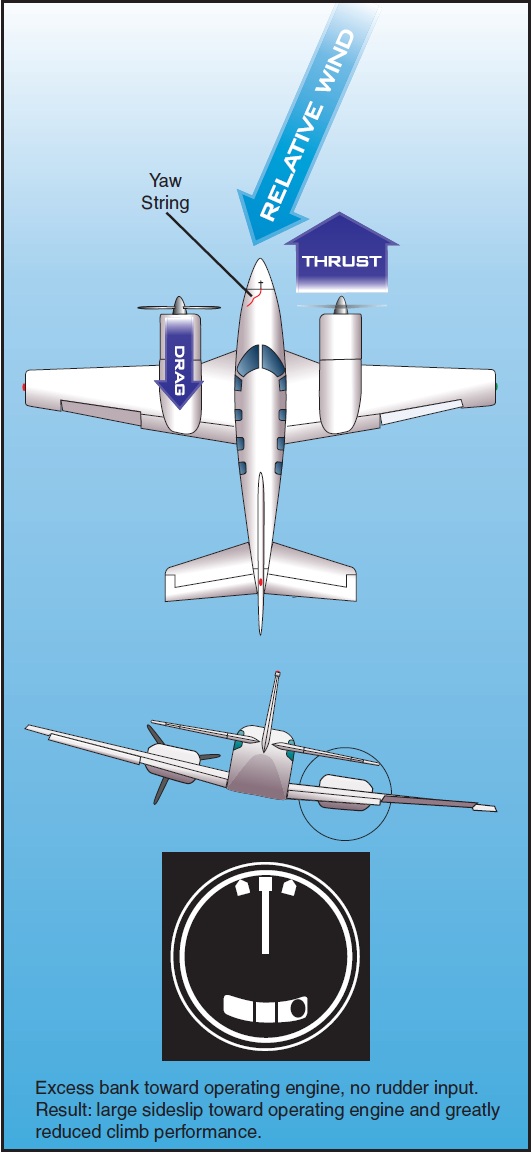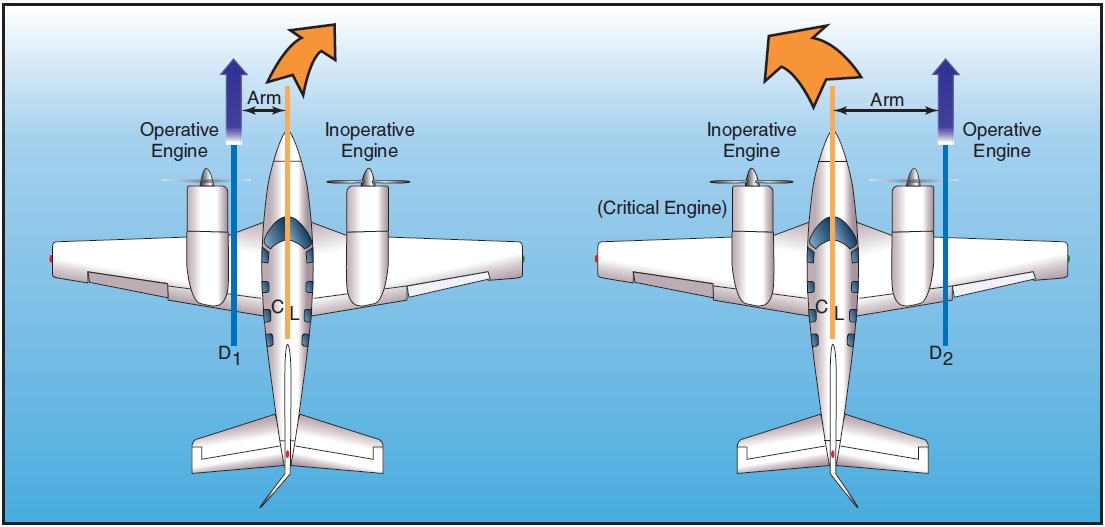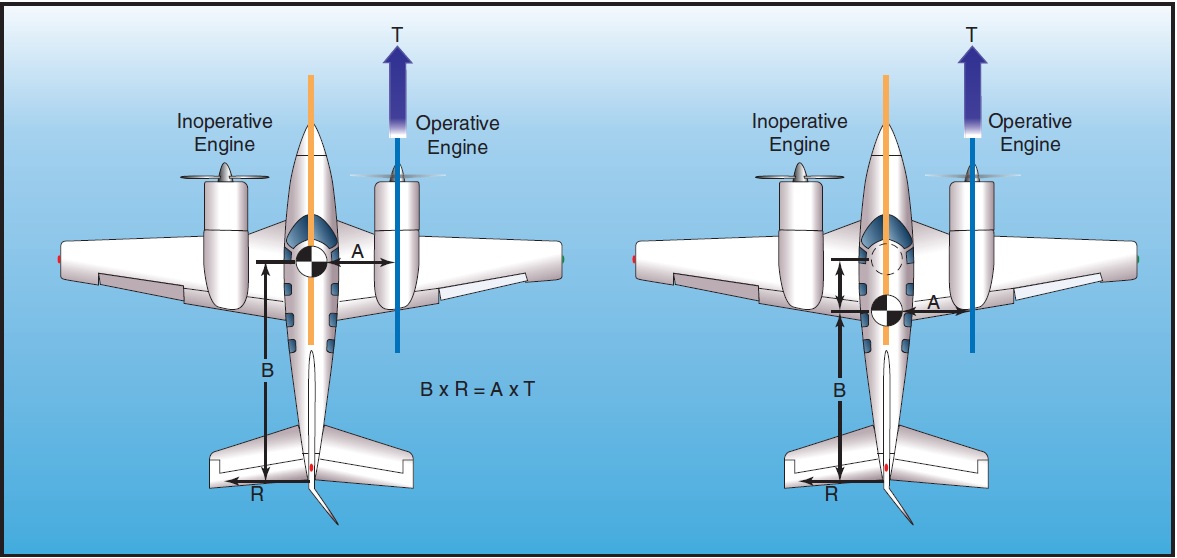
Chapter 12—Transition to Multiengine Airplanes
Table of Contents
Multiengine Flight
General
Terms and Definitions
Operation of Systems
Propellers
Propeller Synchronization
Fuel Crossfeed
Combustion Heater
Flight Director / Autopilot
Yaw Damper
Alternator / Generator
Nose Baggage Compartment
Anti-Icing / Deicing
Performance and Limitations
Weight and Balance
Ground Operation
Normal and Crosswind Takeoff and Climb
Level Off and Cruise
Normal Approach and Landing
Crosswind Approach and Landing
Short-Field Takeoff and Climb
Short-Field Approach and Landing
Go-Around
Rejected Takeoff
Engine Failure After Lift-Off
Engine Failure During Flight
Engine Inoperative Approach Landing
Engine Inoperative Flight Principles
Slow Flight
Stalls
Power-Off Stalls (Approach and Landing)
Power-On Stalls (Takeoff and Departure)
Spin Awareness
Engine Inoperative—Loss of Directional Control Demonstration
Multiengine Training Considerations

ENGINE INOPERATIVE—LOSS OF DIRECTIONAL CONTROL DEMONSTRATION
An engine inoperative—loss of directional control demonstration, often referred to as a “VMC demonstration,” is a required task on the practical test for a multiengine class rating. A thorough knowledge of the factors that affect VMC, as well as its definition, is essential for multiengine pilots, and as such an essential part of that required task. VMC is a speed established by the manufacturer, published in the AFM/POH, and marked on most airspeed indicators with a red radial line. The multiengine pilot must understand that VMC is not a fixed airspeed under all conditions. VMC is a fixed airspeed only for the very specific set of circumstances under which it was determined during aircraft certification. [Figure 12-19]

Figure 12-19. Forces created during single-engine operation.
In reality, VMC varies with a variety of factors as outlined below. The VMC noted in practice and demonstration, or in actual single-engine operation, could be less or even greater than the published value, depending upon conditions and technique.
In aircraft certification, VMC is the sea level calibrated airspeed at which, when the critical engine is suddenly made inoperative, it is possible to maintain control of the airplane with that engine still inoperative and then maintain straight flight at the same speed with an angle of bank of not more than 5°.
The foregoing refers to the determination of VMC under “dynamic” conditions. This technique is only used by highly experienced flight test pilots during aircraft certification. It is never to be attempted outside of these circumstances.
In aircraft certification, there is also a determination of VMC under “static,” or steady-state conditions. If there is a difference between the dynamic and static speeds, the higher of the two is published as VMC. The static determination is simply the ability to maintain straight flight at VMC with a bank angle of not more than 5°. This more closely resembles the VMC demonstration required in the practical test for a multiengine class rating.
The AFM/POH-published VMC is determined with the “critical” engine inoperative. The critical engine is the engine whose failure has the most adverse effect on directional control. On twins with each engine rotating in conventional, clockwise rotation as viewed from the pilot's seat, the critical engine will be the left engine.
Ch 12.qxd 5/7/04 9:55 AM Page 12-28
Multiengine airplanes are subject to P-factor just as single-engine airplanes are. The descending propeller blade of each engine will produce greater thrust than the ascending blade when the airplane is operated under power and at positive angles of attack. The descending propeller blade of the right engine is also a greater distance from the center of gravity, and therefore has a longer moment arm than the descending propeller blade of the left engine. As a result, failure of the left engine will result in the most asymmetrical thrust (adverse yaw) as the right engine will be providing the remaining thrust. [Figure 12-19]
Many twins are designed with a counter-rotating right engine. With this design, the degree of asymmetrical thrust is the same with either engine inoperative. No engine is more critical than the other, and a VMC demonstration may be performed with either engine windmilling.
- In aircraft certification, dynamic VMC is determined
- under the following conditions.
- Maximum available takeoff power. VMC increases as power is increased on the operating engine. With normally aspirated engines, VMC is highest at takeoff power and sea level, and decreases with altitude. With turbocharged engines, takeoff power, and therefore VMC, remains constant with increases in altitude up to the engine’s critical altitude (the altitude where the engine can no longer maintain 100 percent power). Above the critical altitude, VMC decreases just as it would with a normally aspirated engine, whose critical altitude is sea level. VMC tests are conducted at a variety of altitudes. The results of those tests are then extrapolated to a single, sea level value.
- Windmilling propeller. VMC increases with increased drag on the inoperative engine. VMC is highest, therefore, when the critical engine propeller is windmilling at the low pitch, high r.p.m. blade angle. VMC is determined with the critical engine propeller windmilling in the takeoff position, unless the engine is equipped with an autofeather system.
- Most unfavorable weight and center-of-gravity position. VMC increases as the center of gravity is moved aft. The moment arm of the rudder is reduced, and therefore its effectivity is reduced, as the center of gravity is moved aft. At the same time, the moment arm of the propeller blade is increased, aggravating asymmetrical thrust. Invariably, the aft-most CG limit is the most unfavorable CG position. Currently, 14 CFR part 23 calls for VMC to be determined at the most unfavorable weight. For twins certificated under CAR 3 or early 14 CFR part 23, the weight at which VMC was determined was not specified. VMC increases as weight is reduced. [Figure 12-20]

Figure 12-20. Effect of CG location on yaw.
- Landing gear retracted. VMC increases when the landing gear is retracted. Extended landing gear aids directional stability, which tends to decrease VMC.
- Wing flaps in the takeoff position. For most twins, this will be 0° of flaps.
- Cowl flaps in the takeoff position.
- Airplane trimmed for takeoff.
- Airplane airborne and the ground effect negligible.
- Maximum of 5° angle of bank. VMC is highly sensitive to bank angle. To prevent claims of an unrealistically low VMC speed in aircraft certification, the manufacturer is permitted to use a maximum of a 5° bank angle toward the operative engine. The horizontal component of lift generated by the bank assists the rudder in counteracting the asymmetrical thrust of the operative engine. The bank angle works in the manufacturer’s favor in lowering VMC.
12-28
Ch 12.qxd 5/7/04 9:55 AM Page 12-29
VMC is reduced significantly with increases in bank angle. Conversely, VMC increases significantly with decreases in bank angle. Tests have shown that VMC may increase more than 3 knots for each degree of bank angle less than 5°. Loss of directional control may be experienced at speeds almost 20 knots above published VMC when the wings are held level.
The 5° bank angle maximum is a regulatory limit imposed upon manufacturers in aircraft certification. The 5° bank does not inherently establish zero sideslip or best single-engine climb performance. Zero sideslip, and therefore best single-engine climb performance, occurs at bank angles significantly less than 5°. The determination of VMC in certification is solely concerned with the minimum speed for directional control under a very specific set of circumstances, and has nothing to do with climb performance, nor is it the optimum airplane attitude or configuration for climb performance.
During dynamic VMC determination in aircraft certification, cuts of the critical engine using the mixture control are performed by flight test pilots while gradually reducing the speed with each attempt. VMC is the minimum speed at which directional control could be maintained within 20° of the original entry heading when a cut of the critical engine was made. During such tests, the climb angle with both engines operating was high, and the pitch attitude following the engine cut had to be quickly lowered to regain the initial speed. Pilots should never attempt to demonstrate VMC with an engine cut from high power, and never intentionally fail an engine at speeds less than VSSE.
The actual demonstration of VMC and recovery in flight training more closely resembles static VMC determination in aircraft certification. For a demonstration, the pilot should select an altitude that will allow completion of the maneuver at least 3,000 feet AGL. The following description assumes a twin with noncounter-rotating engines, where the left engine is critical.
With the landing gear retracted and the flaps set to the takeoff position, the airplane should be slowed to approximately 10 knots above VSSE or VYSE (whichever is higher) and trimmed for takeoff. For the remainder of the maneuver, the trim setting should not be altered. An entry heading should be selected and high r.p.m. set on both propeller controls. Power on the left engine should be throttled back to idle as the right engine power is advanced to the takeoff setting. The landing gear warning horn will sound as long as a throttle is retarded. The pilots should continue to carefully listen, however, for the stall warning horn, if so equipped, or watch for the stall warning light. The left yawing and rolling moment of the asymmetrical thrust is counteracted primarily with right rudder. A bank angle of 5° (a right bank, in this case) should also be established.
Ch 12.qxd 5/7/04 9:55 AM Page 12-30
While maintaining entry heading, the pitch attitude is slowly increased to decelerate at a rate of 1 knot per second (no faster). As the airplane slows and control effectivity decays, the increasing yawing tendency should be counteracted with additional rudder pressure. Aileron displacement will also increase in order to maintain 5° of bank. An airspeed is soon reached where full right rudder travel and a 5° right bank can no longer counteract the asymmetrical thrust, and the airplane will begin to yaw uncontrollably to the left.
The moment the pilot first recognizes the uncontrollable yaw, or experiences any symptom associated with a stall, the operating engine throttle should be sufficiently retarded to stop the yaw as the pitch attitude is decreased. Recovery is made with a minimum loss of altitude to straight flight on the entry heading at VSSE or VYSE, before setting symmetrical power. The recovery should not be attempted by increasing power on the windmilling engine alone.
To keep the foregoing description simple, there were several important background details that were not covered. The rudder pressure during the demonstration can be quite high. In certification, 150 pounds of force is permitted before the limiting factor becomes rudder pressure, not rudder travel. Most twins will run out of rudder travel long before 150 pounds of pressure is required. Still, it will seem considerable.
Maintaining altitude is not a criterion in accomplishing this maneuver. This is a demonstration of controllability, not performance. Many airplanes will lose (or gain) altitude during the demonstration. Begin the maneuver at an altitude sufficient to allow completion by 3,000 feet AGL.
As discussed earlier, with normally aspirated engines, VMC decreases with altitude. Stalling speed (VS), however, remains the same. Except for a few models, published VMC is almost always higher than VS. At sea level, there is usually a margin of several knots between VMC and VS, but the margin decreases with altitude, and at some altitude, VMC and VS are the same. [Figure 12-21]

Figure 12-21. Graph depicting relationship of VMC to VS.<
Should a stall occur while the airplane is under asymmetrical power, particularly high asymmetrical power, a spin entry is likely. The yawing moment induced from asymmetrical thrust is little different from that induced by full rudder in an intentional spin in the appropriate model of single-engine airplane. In this case, however, the airplane will depart controlled flight in the direction of the idle engine, not in the direction of the applied rudder. Twins are not required to demonstrate recoveries from spins, and their spin recovery characteristics are generally very poor.
Where VS is encountered at or before VMC, the departure from controlled flight may be quite sudden, with strong yawing and rolling tendencies to the inverted position, and a spin entry. Therefore, during a VMC demonstration, if there are any symptoms of an impending stall such as a stall warning light or horn, airframe or elevator buffet, or rapid decay in control effectiveness, the maneuver should be terminated immediately, the angle of attack reduced as the throttle is retarded, and the airplane returned to the entry airspeed. It should be noted that if the pilots are wearing headsets, the sound of a stall warning horn will tend to be masked.
The VMC demonstration only shows the earliest onset of a loss of directional control. It is not a loss of control of the airplane when performed in accordance with the foregoing procedures. A stalled condition should never be allowed to develop. Stalls should never be performed with asymmetrical thrust and the VMC demonstration should never be allowed to degrade into a single-engine stall. A VMC demonstration that is allowed to degrade into a single-engine stall with high asymmetrical thrust is very likely to result in a loss of control of the airplane.
An actual demonstration of VMC may not be possible under certain conditions of density altitude, or with airplanes whose VMC is equal to or less than VS. Under those circumstances, as a training technique, a demonstration of VMC may be safely conducted by artificially limiting rudder travel to simulate maximum available rudder. Limiting rudder travel should be accomplished at a speed well above VS (approximately 20 knots).
The rudder limiting technique avoids the hazards of spinning as a result of stalling with high asymmetrical power, yet is effective in demonstrating the loss of directional control.
The VMC demonstration should never be performed from a high pitch attitude with both engines operating and then reducing power on one engine. The preceding discussion should also give ample warning as to why engine failures are never to be performed at low airspeeds. An unfortunate number of airplanes and pilots have been lost from unwarranted simulated engine failures at low airspeeds that degenerated into loss of control of the airplane. VSSE is the minimum airspeed at which any engine failure should be simulated.
12-30
Ch 12.qxd 5/7/04 9:55 AM Page 12-31
PED Publication